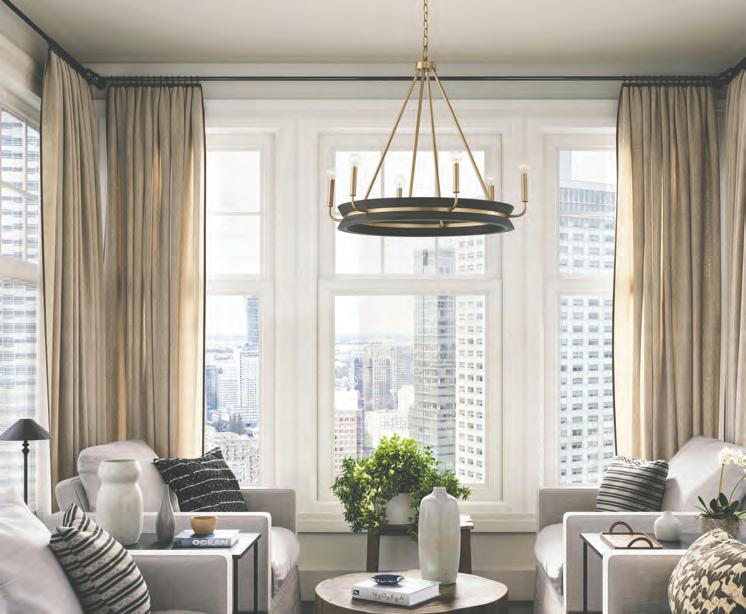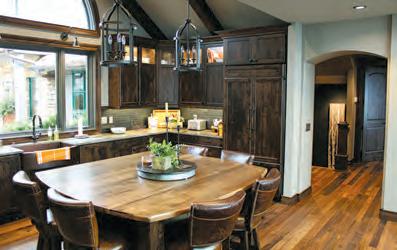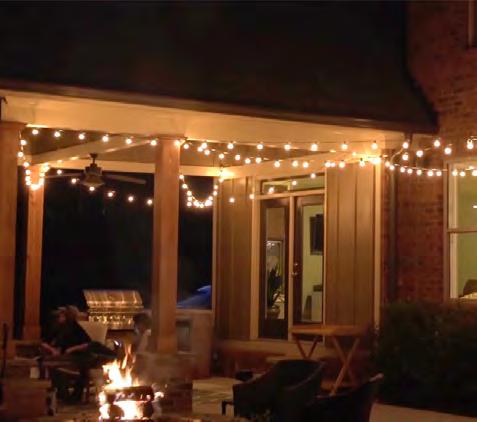IMPROVEMENT Fall Home









While it’s normal to feel nervous about moving into your first apartment, it’s also an exciting time to create your own personal haven. Most rentals have lease limitations on what tenants can and can’t do when it comes to painting and decorating, but there are still ways to infuse your own unique aesthetic into a space.
A new survey from Duck brand asked current and former renters about how they made their temporary spots feel like home.
The survey found that 70% of renters say it’s important for their living space to reflect their personal style and preferences. Although most residents say they are satisfied with the aesthetic of their rentals, respondents still expressed frustration with neutral paint colors and the inability to use nails and screws on the
walls. Additionally, 86% of renters have damaged walls trying to use hooks to hang décor, and 62% have made two to three attempts at hanging décor before getting it right.
“We found that personalizing rental spaces, even if they are temporary, is a top priority for most people, but can feel challenging when you’re on a budget and trying not to cause any damage to walls or surfaces,” says Ashley Luke, senior product manager of Home Solutions at Duck brand. “Luckily, there are a variety of affordable, temporary solutions to try that make it easy for tenants to refresh their nest.”
A popular renter-friendly DIY project to invite color and pattern into white or neutral areas is using removable adhesives, like the Duck brand Adhesive Shelf Liner, to create a backsplash in the kitchen. In fact, 60% of renters say they have used removable décor, like shelf liner and wallpaper, to
Additionally, adding accent pieces around the room, such as a mirror, picture or painting, will make it feel more vibrant. To hang them, choose a tool such as clear, double-sided Duck Max Strength Nano-Grab Gel Tape, which can be used on a variety of surfaces to mount décor. It works in both temporary indoor and outdoor spaces and is removable and reusable.
With some smart strategies, DIY décor can affordably make a space feel like home, without breaching the terms of your lease.

BY SHELBY LINDRUD West Central Tribune
Editor's note: This story has been updated to correct the spelling of John Toupal's surname.
RENVILLE — John Toupal, of Renville, has been passionate about woodworking since he was a teenager, learning beginner skills in his high school shop class. His mother helped him purchase his first table saw when he was 16, and he began building in the garage of his childhood home in Renville.
"When I was 17, Dad said let's build a deck, so I built a deck," Toupal said. "It is still there."
It is a hobby Toupal continued to enjoy throughout his adult life. He worked for 35 years as a machinist, but always had a wood shop. Today, Toupal has turned that hobby into a new business venture, establishing WhatKnot Woodworking, which operates out of the same garage where Toupal first started working with wood.
WhatKnot Woodworking specializes in creating custom cabinets, bars and built-ins for customers. Toupal also creates smaller pieces including cutting boards, wine caddies, coasters and planters.
Installing custom cabinets is a great way to add personality to a space. When starting a project, Toupal first meets with the client and together they come up with a plan that meets the needs of the space.
"That is my favorite part, getting to talk to people," Toupal said. "When you're getting new cabinets, it is kind of exciting. We can come up with ideas together and go from there."
WOODWORKING: D4








There are many ways to put a personal stamp on custom cabinets, from the wood type to the finish. Toupal said painted cabinets, usually in neutral or earth tones, are hugely popular at the moment.
"I haven't done anything with a natural color for quite a while," Toupal said.
The exception to that would probably be bar projects. When building a bar, people usually still want the traditional bar look, which means natural wood with a stained finish "with some neat lighting, glass and shelves for display," Toupal said.
He also offers custom-made butcher block countertops.
There are many options when it comes to the types of cabinets instead of just your traditional uppers and lowers with a few shelves inside. Now, people can have thin and long cabinets to hold cutting boards
— John Toupal
and pans, or corner cabinets with Lazy Susans inside for better storage options.
And on the outside, the door hardware can be the best place for some personalization. Drawer pulls can be traditional, modern, whimsical and everything in between.
"You can get such fun hardware," Toupal said. "And there are such neat storage things, storage hardware you can buy."

Contributed / John Toupal, WhatKnot Woodworking John Toupal does all the work when building his custom cabinets, from cutting and sanding the wood, to painting and then install.
After the design is completed, Toupal takes measurements and then head back to his shop to start building. He builds everything at his Renville shop. Depending on the size and complexity of the job, it can take several weeks for Toupal to build the cabinets.
"I try and have everything assembled here for the most part," Toupal said, who also paints the cabinets.
Once he is finished building the cabinets he goes to the client's home to install. He will remove old cabinets if needed and then install the new ones.
"I like doing custom, specialist stuff for people," Toupal said.
When not building cabinets, Toupal likes to create smaller pieces. He first started with wine caddies, which made sense, as Toupal and his wife also make fruit wine.
He has since expanded to making cutting boards, coasters, plant hangers, plant stands and more. He recently bought a laser engraver, which allows him to personalize pieces.
"It's fun, just to do coasters and things like that," Toupal said. "Then to augment some of them, like the planters, using the engraver, to personalize things."
Toupal, along with his wife, sometimes sells his smaller creations at local and regional arts and craft fairs, such as the fall show in Clara City. This year, WhatKnot

Contributed / John Toupal, WhatKnot Woodworking
This photo shows a set of completed painted lower cabinets and butcher block countertop by John Toupal of WhatKnot Woodworking.






Woodworking will have a booth at the University of Minnesota Arboretum gift market in December. He also sells some things on his website and plans to open up an Etsy shop soon.
Going forward, Toupal wants to work more on 3-D cutting boards and perhaps get into expoxy pour tables, a project his wife would like to try.
"She is really, really interested in that," Toupal said. "We thought about doing that together."
While Toupal has been a woodworker most of his life, he didn't start doing it full time until 2023. This first year has been both a positive and a challenge as Toupal gets his new business started. He has done some kitchens, art pieces and even built the ramp outside of the old United Methodist Church, now home to the Renville Friends of the Arts organization.
"I am getting out there and getting our system set up," Toupal said.
None of it would have been possible without the support of his family and friends, going back to his parents, who allowed him to make a mess in the garage.
"They really supported me," Toupal said.
He has also received inspiration and influence from people like his brother-
in-law Joe Larkin and his industrial arts teachers. While mostly self-taught, Toupal did take a course at Woodscraft in the Twin Cities, learning from wellknown craftsman Tom Caspar.
"That really got me, because he is just so talented and so knowledgeable," Toupal said.
Toupal has also been known to turn to the internet to learn how to do something or get new ideas.
"Now, with the magic of computers and YouTube, if there is anything you have an interest in you can just take a peek and before you know it you're hours in," Toupal said.
He has taken all his skills, creativity and inspiration to create WhatNot Woodworking, allowing him to live his dream of doing what he loves. He enjoys taking a simple piece of wood and turning it into something beautiful.
"It is very relaxing, the days just go away," Toupal said.
Toupal is happy to help people create their dream kitchens or solve their storage needs with his custom cabinets and built-ins.
"If there is anything you're thinking about trying to put in your house, or have built, I'd love to look at it," Toupal said.









With the all-white kitchen design trend on the decline, you may be wondering how to make updates that appeal to today’s sensibilities. The key is infusing color and depth into your space. Here’s how:
Earthy wood tones easily transform a predominantly white space and there are many ways to incorporate this look in your kitchen. Options can be as involved as refinishing your kitchen island with a wooden countertop or swapping in wood cabinet finishes, to as simple as introducing a rolling bar cart into the space. Displaying a few wooden kitchen elements, such as cooking utensils, cutting boards and a napkin holder, can round out the look.
Matte black appliances are gaining in popularity for good reason – they can elevate your kitchen into a glamorous foodie oasis, and a place where cooking, eating, and gathering with loved ones brings you joy. It’s helpful if those appliances pair form with functionality. When it comes to cooking ranges, check out Verona, which offers professional-style Italian-made appliances that combine artistry with the latest cooking technology innovations. The brand’s Ultima Midnight 36-inch Range is fully matte black from cooktop to legs for a sleek look and is available in dual fuel or induction.
Alternatively, the Maestro collection from another Italian brand, Lofra, boasts strong versatile design and the highest technical performance. Both brands are exclusively imported by EuroChef USA. For more information, visit eurochefusa.com.

Brass accents can provide dynamism and depth. Consider adding brass hardware to your fridge and updating your faucet and sink basin in a gold or bronze tone. For your cooking range, get inspired by the models available in Lofra’s Dolcevita Collection, which can be customized with brass trim, and gold knobs, providing pops of color in unexpected places, and with 30-60-inch models available, can accommodate kitchens of all sizes.



Beyond the trim of your appliances, you can mix these metals into your space by swapping in new cabinetry hardware and by adding in an eye-catching brass pedant above your dining area or prep space. Displaying your brass cookware on hooks or a rack can offer a rustic and homey feel to an otherwise austere space.
If you spend a lot of time in your kitchen, as many individuals and families do, consider updates that add color, depth and comfort to the space.
In today's construction landscape, homeowners-to-be encounter numerous challenges, like budget overruns and delays. This is why selecting the right contractor and thoroughly scrutinizing the contract are crucial.
Glen Harris III, of Alair Florida, stressed transparent processes and client control in his dealings with clients. Here are five key elements to consider for a successful construction experience based on Harris’ insights, and the results of an Ipsos and Hover survey of 500 adults involved in home renovation projects.
1. A detailed planning process: Har ris advocates for a comprehensive planning phase that lays the groundwork for precise budgets, schedules and scopes. This aligns with findings from the survey, which reveal that 58% of homeowners experienced time delays averaging about 40 days. A thorough planning
process mitigates ambiguity and sets realistic expectations from the outset, preventing costly delays down the line.
2. Transparency throughout: With a traditional "cost plus" contract, transparency can be limited to monthly cost breakdowns after completion. Instead, prioritize a contract that promises transparency from conception. According to the survey, more than a third of homeowners reported paying more than the original quote, with the additional costs averaging $19,000. Contracts should ensure continuous insight into project costs, schedule updates and scope changes, empowering homeowners to make informed decisions and maintain control over their investment.
3. Client involvement: Harris encourages "client control," stressing active participation in the planning phase. The survey shows nearly half of homeowners faced avoidable issues, causing strained relationships and setbacks. Contracts should foster teamwork, keep clients informed and engaged in decisionmaking, and reduce misunderstandings




for a smoother construction process.
4. Technology integration: Harris emphasizes the role of technology in managing projects, highlighting Microsoft Business Central for realtime access to project data. Using such platforms improves transparency and communication between contractors and homeowners. The survey highlights that 31% of homeowners find budgeting the most challenging aspect of the process, emphasizing the importance of streamlined systems for clarity and efficiency.
5. Trust and reputation: Trust is paramount in the homeowner-contractor relationship, with reputation ranking as the most important characteristic for homeowners when selecting a contractor. The survey reveals that half of homeowners prioritize fair pricing, while 40% value contractor knowledge and 35% emphasize good communication skills. Contracts should reflect these priorities, instilling confidence in homeowners and fostering strong partnerships built on trust and reliability.
Alair market partner and renowned home designer Dave Jenkins, of Wright Jenkins, emphasizes thorough planning and transparent communication throughout the construction process.
"Our clients love to be kept in the loop with our cutting-edge design and communication. A well-defined planning phase sets the stage for success and minimizes costly delays and misunderstandings," Jenkins said. "Transparency and communication are essential for building trust and alignment on project goals."
For more information about new construction and home remodeling, visit www.Alairflorida.com.
By prioritizing these elements in a contractor's contract, homeowners can navigate construction confidently, mitigating risks and ensuring a positive outcome. Reviewing and understanding these aspects of the contract is crucial for safeguarding investments and achieving project success.




BY ANDREW DEHAN Bankrate.com (TNS)
It’s not just retirees choosing to downsize — with today’s elevated housing costs, many people are looking to smaller properties for relief. In fact, 44% of U.S. adults who would be willing to make a sacrifice to find more affordable housing say they would consider downsizing their living space, according to Bankrate’s 2024 Home Affordability Report.
But living smaller comes with its challenges. Let’s weigh in on why people may want a smaller footprint, as well as the benefits and drawbacks of downsizing your home.
Why buy a smaller house?
The short answer is, to save money: High mortgage rates and even higher home prices are two major reasons people look to buy a home that’s on the small side. A lower price tag on your house means borrowing less money to make the purchase and paying less interest over time.
But location is another reason people may choose to live smaller. Many people will opt for convenience, abundant amenities and a shorter commute to work over more square footage.
“Usually, it’s more expensive to be closer to a big city,” says Maggie Johndrow, partner and financial advisor at Johndrow Wealth Management in Connecticut. “I see folks choose to get a smaller home [in or near the city], even though they could maybe afford a bigger home at the same price a little bit further out from the city.”
Living with a smaller footprint can have many benefits, both for your finances and your lifestyle.





Opting to live in a smaller home can translate to bigger savings in maintenance and upkeep. “A smaller home means smaller utility prices and not having to buy as many goods to fill it up,” says Johndrow. “And with inflation elevated, as we’ve seen over the past couple of years, folks are mindful of that.”
Property taxes and home insurance premiums are often lower when you choose a smaller and less expensive home, too. And

small homes usually have easier-to-manage yards as well — something to keep in mind for lawn-care and landscaping costs.
Having a larger home can also mean more work. Not only do you have to keep up with maintaining the house itself, but you also have to take care of everything in it. For Erin Hybart, a real estate agent in Louisiana who specializes in tiny homes, living smaller translates to simplicity.
“People are spending their lives working to pay for their house, and then even more of their time cleaning it,” Hybart says. In addition, when people have large homes with plenty of storage, they can easily forget about their belongings and get overwhelmed by their stuff. She says that clients often find they’ve bought duplicate items because they forgot they already had something: They’ll say, "Oh my gosh, I haven’t seen this in three years. Why do I have five of these?” she says.
Another plus: Having to spend less time and money on your house, and the stuff in it, opens up other opportunities, such as pursuing education or traveling.
Larger homes require more energy to keep running, particularly when it comes to heating and cooling. And outfitting a large home with energy-efficient appliances and lighting can be expensive, as are new windows and upgraded insulation. If you’re eco-minded, it may just be easier to live in a smaller space.

“If sustainability or environmental stuff is important to a homebuyer, they can integrate that much more easily when the space is smaller,” says Hybart. “They don’t have to put, you know, $40,000 worth of solar panels on their house.”
When you choose to live smaller, you often shift your focus away from spending time in your home. You may find yourself using your outdoor space more, such as relaxing on the porch or in a hammock instead of in your living room. And for those in more scenic areas, that could mean enjoying the great outdoors with activities like hiking or fishing.
People who live in cities might make more use of the city’s amenities and entertainment options. “Find other things that you enjoy, like a brewery or a park to spend time in,” says Johndrow.
For some, a smaller space can be a positive, but for others, it’s decidedly not.
Obviously, living smaller puts you in closer quarters with your family. This isn’t always a plus — it can cause serious friction, especially if you work from home and/or have a large family. And if your area has limited entertainment options or outdoor activities are limited due to weather,








small spaces can begin to feel cramped very quickly.
In some circumstances, downsizing your home can actually mean more expenses instead of less. For instance, if you bought your current home several years ago, it’s important to keep in mind that home prices have increased significantly since then. Look into whether a new home in your desired area, even if it’s smaller, might cost more than what you can sell your current home for, says Johndrow.
“Are you willing to use cash to pay for the smaller home, from the proceeds of your larger home, or are you going to get a mortgage?” says Johndrow. If you’re getting a mortgage, she says, keep in mind that interest rates are much higher now than they were just two years ago.
Another thing to consider is whether your new home is part of a homeowners association. Many smaller homes are, especially in new developments, and HOA fees are something to budget for.
The amount can vary widely: “I’ve seen those range from a few hundred bucks a month to even creeping into the $1,000 a month territory, depending on where you live and the amenities that they provide,” Johndrow says.
If you’re looking for a smaller property, you may have to look harder than most.
The average size of a new home in 2023 was 2,411 square feet, according to the National Association of Home Builders. While this is a 13-year low, it’s still much larger than many looking to downsize might need. To find a smaller single-family home, you may need to be willing to buy an older home, and possibly be flexible about its location.
This is especially true for a trendy tiny home, for which residential zoning is another factor to think about. Finding a place to build a tiny home can be tricky depending on the zoning in your area, Hybart says. They can also be difficult to fund with a traditional mortgage.

Whether you’re planning to move to a smaller place soon or you’re just looking for a more minimalist lifestyle, you can start downsizing your home by changing the way you use the space you already live in.
• Downsize your possessions: Declutter your closets, throwing out or donating what you don’t need, and pare down what you own to the essentials. A big part of the appeal of a smaller home is its manageability — reducing the

amount of stuff you have can reduce the upkeep of your current space.
• Rethink how you use your space: Now that your home is not stuffed to the gills with unneeded items, what can you do with the space you’ve created? You might find that you now have room for a dedicated home office, a den, a craft area or a more organized storage opportunity.
• Consider your indoor climate: Heating and cooling can be expensive. One way to reduce your energy bill is to install a smart thermostat to adjust

the temperature with the weather. You may also consider blocking off an underused room in extreme weather months or getting an energy-efficient portable air conditioner or heater to use in just one specific room.
Even if you aren’t actually downsizing your home anytime soon, spending less time and money caring for your belongings can help you prioritize what really matters to you.
©2024 Bankrate.com. Distributed by Tribune Content Agency, LLC.

Outdoor lighting can extend the time you can spend enjoying your backyard with your friends and family. While there are a host of involved and expensive outdoor lighting solutions, there’s one easy DIY alternative that offers a lot of charm.
“String lights are a beautiful, inexpensive and fun way to add personality and ambience to your yard and patio,” said expert landscape designer Doug Scott.
In a recent Exmark Done-In-A-Weekend Projects video, Scott demonstrates how to hang simple, cost-effective backyard lighting. With the best part of the summer still on tap, he is offering his steps for this two-day project for improving your outdoor living space:
• Determine where you’ll hang your
lights. You can hang them from fence posts, on trees, off porch railings, or even purchase light stakes that do the hard work for you.
• Research the style of backyard lights that you want to use.
• Sketch an outline or design of how you want the lights to look. You may want to crisscross the lights or string them just around the perimeter of the patio. Knowing your design will help you determine how many strands of lights you need. Just be sure your design represents you and how you want to live outside.
• Determine what installation equipment you need. You may need extra equipment such as an extension cord or hardware to hang the lights. Make sure that all hardware is weatherproof and outdoor-grade.
• Measure the area where you’ll hang your lights, being sure to leave room for slack and to reach the outlet.
• When you be gin hanging the lights, try to have the light strand

connections be as discrete as possible.
• Install light hooks.
• Hang outdoor string lights. To avoid breakage, remove all of the bulbs from the light strings before hanging them. Once the strings are hung, install one bulb in each strand and test it to make sure it works. Then add the remaining bulbs.
• Reveal your space. Now it’s time to light up your backyard living space and kick back and enjoy!
To view the tutorial and get inspired, visit Exmark’s Backyard Life, a multimedia destination that provides everything from lawn care tips to gardening and outdoor hosting advice, at exmark.com/backyard.
String or strand outdoor lighting will add after-dark pizzazz to your outdoor living space. And though this improvement makes a big atmospheric impact, it’s one that won’t break the bank.







Perhaps you’re better off not taking that new sofa out of its plastic wrap. Sofas, couches and loveseats top the list of furniture most likely to be damaged, according to the latest survey on furniture damage from Allstate Protection Plans. What’s worse, more than half of furniture purchases were damaged in the first two years!
A whopping 174.8 million Americans have damaged furniture, and 61% of accidents occurred in the first two years of ownership.
Here are insights from this survey, along with information on what consumers did to repair, replace or hide damage:
• Failure frequencies: When asked which furniture was damaged most recently, 40% of Americans said sofas, couches and loveseats. People spent $299 on average repairing or replacing them. And 17% of accidents happened in the first six months after purchase.
• Drips and rips: Spills and stains were the leading cause of damage, accounting for over half (55%). Rips and tears were second (25%). Juices accounted for 25% of stains, while people and pet stains accounted for 21%.
• Four le gs versus two: Surprisingly, pets and children were less likely to be responsible for damage than adults. Forty-five percent of adults blamed spouses for damage, with children responsible for 34%. Dogs were twice as likely as cats to cause damage.
• Dealing with damage: Fortythree percent of people tried to fix damage themselves, while 38% kept using furniture despite


damage. Twenty-three percent hide it, with 14% replacing items and 4% repairing them.
• Fear of fancy furniture: Over a third (36%) avoided buying high-priced furniture for fear of damage. While 54% were aware protection plans can cover sofas, only 31% understood
they can cover beds, and just 12% knew they can cover area rugs.
• Preventive measures: Thirtyeight percent of Americans have covered furniture with towels or sheets, 29% have used slipcovers and plastic covers, and 20% have used stain prevention treatments.
Just over a fifth (22%) currently have a protection plan or extended warranty for furniture.
“While people are used to protecting electronics, many don’t know they can protect furniture too. It gives you peace of mind, knowing expert help is there when you need it,” says Jason Siciliano, vice president of marketing and creative director at Allstate Protection Plans.
To protect furniture, the experts at Allstate Protection Plans recommend:
• Clean regularly: Dust and dirt buildup can cause scratches and abrasions, or worse. Cleaning is important for hightraffic items like area rugs.
• Use coasters and mats: They can prevent rings and stains from moisture and heat.
• Invest in protective covers: For both indoor and outdoor furniture, especially high-use pieces, covers can help.
• Rotate and rearrange: Rotate cushions periodically to distribute weight and wear.
• Control environmental factors: Regulate temperature and humidity. Close curtains or blinds to stop fabric or wood from fading in the sun.
• Consider a protection plan: The coverage can include accidental damage, stains and structural issues, and protect your financial investment.
More tips and information are available at www.allstateprotectionplans.com.
Since we’re only human, stains and damage will happen. With a few simple steps you can rest easy when sitting on that new sofa.

of Alair Sanibel, a custom home builder in Southwest Florida.
Elevating your outdoor space into a luxurious retreat that rivals a high-end resort is a dream that many homeowners share. Whether you're renovating your current property, planning a complete transformation, or starting fresh with a custom build, use these tips and design elements to get started.
• Embrace seamless indoor-outdoor living: Create a seamless transition between indoor and outdoor spaces by incorporating features like bi-fold doors or expansive sliding glass doors that open onto a patio or courtyard. This continuous flow enhances your living experience and sets the stage for a resort-like ambiance.
• Go big and bold with backyard landscaping: According to experts, landscaping should provide contrast. "Incorporate modern aesthetics into your backyard with bold and innovative landscaping that includes both hard and soft elements," said Kevin Scott, owner and partner
• Put modern twists on natural elements: Bringing the beauty of nature into your outdoor design will create a calming environment. To maintain a contemporary feel, use materials like stone, wood and bamboo in creative ways, such as with modern sculptural planters, sleek wooden decking or minimalist stone pathways.
• Create a cozy "sane-tuary": Leili Fatemi, of Leili Design Studio, recommends transforming your outdoor space into an extension of your interiors to achieve harmony. Choose cozy and comfortable furniture like sofas, lounges, swings and dining sets, and add finishing touches such as pillows, rugs and accessories. "When selecting outdoor items, opt for weather-resistant materials like wrought iron, teakwood, and outdoor-grade wicker and fabrics that are 100% solutiondyed acrylic for fade- and mildewresistance," said Fatemi, emphasizing the importance of easy-care living.

• Introduce water features and outdoor luxury showers: Capture the resort-like feel by incorporating water features such as fountains, reflecting pools or small waterfalls, as well as stunning additions like outdoor luxury showers for a spa-like experience.
• Enhance ambiance with outdoor sound systems: Install high-quality sound systems so you can enjoy convenience and comfort outdoors, whether relaxing or entertaining guests.
• Illuminate with smart outdoor lighting: Consider installing smart outdoor lighting systems that can be controlled remotely to improve security and safety and to highlight landscaping and architectural features at night.
• Create a versatile outdoor retreat: Incorporate a backyard studio that can serve as a sheltered spot for various purposes such as a guest room, home office or party room.
• Focus on wellness and entertainment: Design outdoor spaces that promote wellness and
entertainment. LeTricia Zogheib of Zogheib Necessary Luxury recommends incorporating features like a giant chess set or innovative installations. "I recently had a client request an outdoor TV installed at the end of his pool that could rise from the ground and rotate for different seating positions," Zogheib said.
• Partner with expert builders: Collaborate with experienced builders specializing in outdoor luxury design. "A reputable builder can ensure that your outdoor retreat is crafted with precision and attention to detail," said Glen Harris III, regional partner at Alair Florida.
To explore how experts can help you create an outdoor living space that rivals the experience of a high-end resort, visit www.alairflorida.com.
With thoughtful design, premium materials, attention to detail and the expertise of knowledgeable professionals, you can transform your outdoor area into a luxurious retreat where every day feels like a getaway.
















Did you know that you don’t have to spend tons of time or money on home interior updates? In fact, you don’t even have to engage a contractor to elevate your spaces in a big way.
Here are three stunning methods for completely transforming stained, burned or otherwise drab countertop surfaces in your kitchen, bath or other areas of your home. The beauty is that each project costs less than $300, and you can complete one in a weekend, even if you don’t consider yourself especially handy:
• A marble look: Installing marble countertops can cost thousands of dollars and disrupt your life for weeks, if not months. Fortunately, there’s a way to get the same beautiful, one-ofa-kind look of marble with just a few supplies. The Marble Dream Resurfacing Kit from Daich Coatings is a new stone coating system engineered to be applied in a few simple steps, with no special artistic skill required. Available in both Pristine White and Cosmos Black, every installation will look completely unique based on how you blend the product. After prepping your surface and applying the base coat, the glaze mix and the vein accent colors, you use a blow dryer to push the colors around, deciding for yourself how they get blended, and the direction and strength of the details and finish. Designed so you can work at a relaxed pace and make changes on the fly, cleanup is a snap for this project. And the water-based, odorless formula is safe too, so you won’t be exposed to anything hazardous. When you’re finished, not only will your countertops look revitalized, they’ll

Countertop updates don't have to cost a fortune, or even take a lot of time.



offer superior heat, impact and scratch resistance for greater utility. The brand makes installation easy by providing a detailed online video tutorial.
• Real granite finish: Real granite countertops are an elegant, natural upgrade that can take your kitchen or bath to a whole new level. But what if you didn’t have to commit to the complicated construction, scary price tag or long wait time of a full stone slab to get the authentic look and performance of smooth, polished granite? The LuxROCK Solid Surface Granite Kit by Daich Coatings allows you to add a premium stone surface -- complete with the visual pop of mineral highlights and sparkling accents — right over your existing countertop, without the mess or hassle of tearing out your current surface. Available in five beautiful colors, you can renew existing countertops made of laminate, wood, concrete, stone and more in just a weekend, and have the flexibility to economically switch to a new look if you’d ever like to refresh.
• Naturalized, speckled stone: For more of a natural speckled stone appearance, consider the 11 colors available in the SpreadStone Countertop Finishing Kit, which allows you to tailor your texture. This two-step project takes two days to complete, with results that will last for many years. In addition to a range of interior applications, you can also use this kit on exterior surfaces, including bar tops, barbecue areas, tables and

more. Like the other kits, there is no need to remove sinks, plumbing fixtures or your current countertop to make this renovation, and your finished product will be food safe and intact with a polyurethane clear coat.













